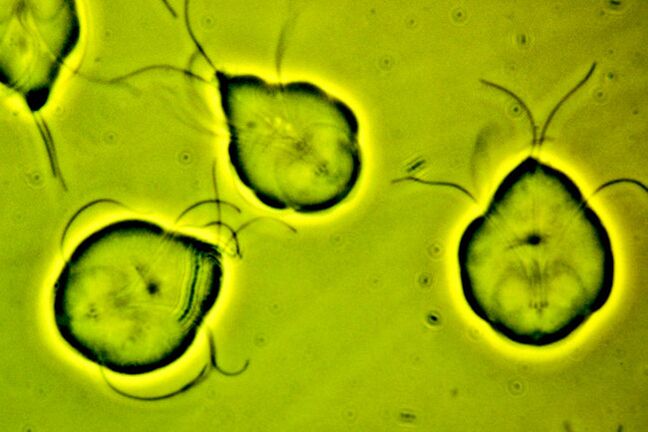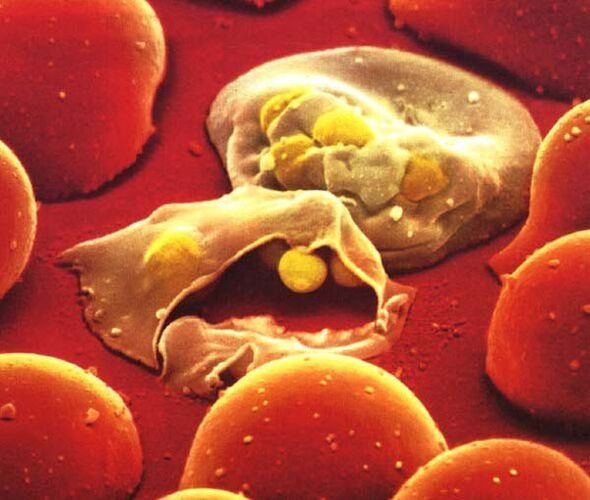When it comes to parasites in the body, most people think of worms in the gut. However, other parasites are also common, which are quite difficult to diagnose and affect organs other than the intestines.
These are the simplest microscopic (most commonly parasites) that do not appear for a long time. However, the simplest parasites can cause significant damage to the body.
Giardia
Giardia is a microscopically sized, flagellated parasite with two nuclei and two sets of organelles.

In humans, giardiasis is caused by the most common type of parasite, the intestinal lamblia. In addition to humans, other mammals and birds can become infected. The parasite can form a cyst in the localizing organ.
Giardia is present in poorly treated tap water as well as in natural springs - springs, wells. They can be found in the meat of an infected animal, a bird, in small amounts in the feces of an infected animal, and sometimes they survive in the soil, so they are present on vegetables and berries.
Infection is usually via the fecal-oral route, meaning that a significant number of parasite cysts need to be ingested to cause invasion. Generally, children are three months of age and adults are ill.
Most often, the disease is asymptomatic and the patient is accidentally informed about it. But sometimes there are some symptoms (permanent or intermittent). Symptoms from the gastrointestinal tract reveal:
- Abdominal pain;
- bloating;
- Nausea, sometimes vomiting;
- Stomach upset;
- Constipation and diarrhea alternate;
- Biliary dyskinesia;
- Skin allergies;
- General weakness.
Like intracellular parasites, lamellae are mainly treated with metronidazole. However, in the first stage of therapy, the intoxication should be removed and the work of the bile ducts should be normalized. Only then will antiparasitic therapy be prescribed. Thereafter, therapy is performed to restore the body's defenses and increase immunity.
Amoeba
Amoebas are the simplest human parasites that cause amoebic blood clots or amoebiasis.
There are also types of amoebae that can affect the eye. It causes amoebic encephalitis but is less common. Invasion is not the most common, with the WHO saying only 10% of people are ill (compared with 50% according to some sources for giardiasis).
Amoebas spread exclusively through the fecal-oral route, meaning that, as in the previous case, amoebas form cysts that must be swallowed to develop infection.
The likelihood of infection is higher in countries with hot climates and poor health conditions. Cysts retain their infectivity for a long time on vegetables and berries grown in soil, water, and contaminated soil. Cockroaches and flies carry these cysts to some extent.
Like intracellular parasites, amoebas cause symptoms only 7 to 10 days after infection. Symptoms of colitis include: abdominal pain (in the lower part), general weakness, a slight rise in body temperature. The liver is most often affected because after two to three weeks there are pains in it, the organ grows and thickens.
Toxoplasma
Toxoplasmosis is a disease that causes Toxoplasma trouble. It is the simplest organization distributed mainly by members of the feline family, which are carriers. An infected person can also spread it.
It is spread by faecal-oral routes. You can become infected if you eat poorly processed meat and eggs from infected animals and birds. To a lesser extent, it may still spread through blood, in the presence of wounds (such as when working with contaminated soil in the garden), and in contact with mucous membranes.
It is mostly asymptomatic and, like many viruses, is accidentally diagnosed, for example, in an enzyme-linked immunosorbent assay. In the acute form, healing often occurs on its own. Pregnant women require pyrimethamine medication (used to treat intracellular parasites).
Plasmodium
Plasmodia are intracellular parasites that cause malaria. Five pathogens can live in humans. In addition, they are localized in the blood, on the membrane of its cells.
The disease is spread by blood (such as transfusion). Some mosquito species also tolerate being bitten because mosquitoes are intermediate hosts of plasmodium. As a result, a person becomes infected with malaria.
These mosquitoes (and accordingly the disease) are common in hot countries, especially in Africa.
Malaria has severe symptoms that begin to appear 5 to 7 days after infection. The first symptoms are joint pain, fever, severe chills. Then a headache, spleen enlargement joins.

Treatment is with quinine preparations under strict medical supervision.
Trichomonas
These are the simplest human parasites that cause trichomoniasis. It affects the human urinary system. It is the most common sexually transmitted disease as well as the most common disease of the urinary system.
It is spread only through sexual contact. In women, they live in the vagina, in Trichomonas men - in the urethra, the seminal vesicles, the prostate gland.
In women, the symptoms are: vaginal discharge, itching and redness of the skin of the genitals, pain during urination and sexual contact, inflammation of the vaginal mucosa. In men: discharge from the urethra (rarely with blood), pain when urinating, symptoms of prostatitis with damage to the prostate gland.

Both partners need treatment for the disease. Medicines against Trichomonas are treated strictly individually and under medical supervision. In some cases, immunotherapy or symptomatic therapy may be required.
























